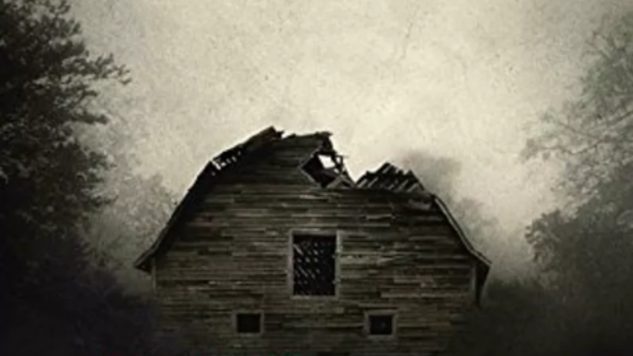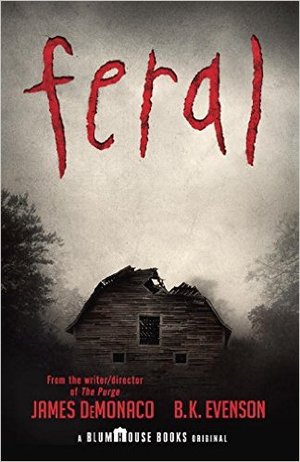Feral, By The Purge Screenwriter James DeMonaco and B.K. Evenson, Fails as a Horror Novel
Books Reviews horror
Feral should not be a novel.
One of the book’s coauthors, James DeMonaco, wrote and directed The Purge. And everything about Feral, from its reliance on physical action set pieces to its saucepan characters—shallow but popping—suggests it would instead make for a fine movie or, perhaps, a videogame.
Feral begins with a cataclysmic accident. A gene-altering virus is released from a lab, and any male who comes into contact with it begins oozing pus and blood from his orifices before his body starts running hot, muscles convulsing, strength and speed increasing. These “ferals” are a caricature of brute masculinity—with a knowing nod toward the sexually attractive aspects of savagery. The women who escape the initial slaughter arm themselves and carve out a life in yet another post-apocalyptic world.
 To the book’s credit, it barely wears its pseudoscience like a veil, discarding it just as easily. The concept of “men reduced into monsters” resonates deeply, although what nuances could be excavated are lost, requiring a scalpel where Feral uses a machete. There are some rote explanations involving chromosomes for the ferals’ aggression, which manages to be both numbingly complex and embarrassingly simple at once. (The novel’s most ridiculous scientific part involves learning that the original goal was to make hyper-aggressive war primates.)
To the book’s credit, it barely wears its pseudoscience like a veil, discarding it just as easily. The concept of “men reduced into monsters” resonates deeply, although what nuances could be excavated are lost, requiring a scalpel where Feral uses a machete. There are some rote explanations involving chromosomes for the ferals’ aggression, which manages to be both numbingly complex and embarrassingly simple at once. (The novel’s most ridiculous scientific part involves learning that the original goal was to make hyper-aggressive war primates.)
Covering multiple years and various survivors’ viewpoints with the manic energy of a horsefly, Feral reads something like a screenplay, which is not necessarily a bad thing. Page-long blocks of italicized hand waving set the stage at various points, the words leaning forward in anticipation of action. When that action comes—and it comes often—the shift to third person perspective is a welcome trick, one counterbalanced by various first person interludes which do less to advance the story than to apply some background.
Such efforts are akin to putting silk on a skeleton, however. Main protagonist Allie Hilts is a badass, her lacrosse-star athleticism having been honed to a ferocious degree. Her sister, Kim, mainly exists as an exposition machine and motivation, and the rest of the cast ranges from benign—a weed-smoking doctor seeking both redemption and a cure—to borderline offensive—a spiky-haired martial lesbian whose hatred of the ferals runs right up against misandry, threatening to turn her into a straw man stereotype.
The prose is at its best when describing action. When there’s nothing to kill, however, prosaic turns creep out of the woodwork like centipedes, inducing eye rolls. The deeper reflection of what it means when men become monsters—and of how little they had to change—is left behind by Feral’s brutal pace. The book’s big twist threatens to undue the whole concept altogether, choking off the most interesting concept while at the same time diluting Allie’s character.
Some moments do shine. The opening scenes, set in Allie’s high school right as the virus hits, play well with the arriving menace. And the politics of teenagers, sex and violence give these initial moments something of a Jennifer’s Body vibe. Had the book truly wanted to explore the men-as-monsters concept, it should have never strayed from this promising start. The action scenes themselves are instantly visualized—speaking to the screenwriting pedigree behind Feral—and gruesome enough, with the climax particularly fun (minus one disgusting aspect: the ferals’ capture of women as breeding stock, which seems distasteful when sexual violence could have been examined in a more nuanced way).
Feral’s fatal flaw is that it’s built around a simple but powerful idea: that men—who already rape, kill, beat, threaten, humiliate—simply give in as ferals to this horrifying undercurrent of aggression. The novel had a chance to allow men to see themselves for the threat they can so easily be. What Feral delivers instead is social issue lip service atop a standard issue “end of the world as we know it” warning shot of a story—slight, fast, loud and glancing.
B. David Zarley is a freelance journalist, essayis, and book/art critic based in Chicago. A former book critic for The Myrtle Beach Sun News, his work can be seen in Hazlitt, Sports Illustrated, The Chicago Reader, VICE Sports, The Creators Project, Sports on Earth and New American Paintings, among numerous other publications. You can find him on Twitter or at his website.